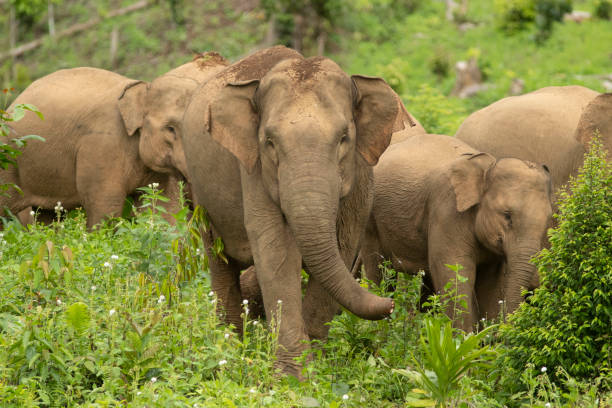
Seeing Life from the Eyes of Sumatran Elephants
In a lush and green rainforest of Sumatra lives a majestic creature with deep family ties and a
memory as long as the rivers they follow — the Sumatran elephant. This animal is known for its
intelligent and loving soul. Unfortunately, they are right now considered a critically endangered
subspecies of the Asian elephant. Beyond their breathtaking beauty, they also have rich stories
about social life, survival, and natural harmony.
A Close-Knit Community
Like us humans, Sumatran elephants are highly social animals that live in close herds. The
group consists of some females and their young, led by the oldest and most experienced female
— called the matriarch. Her wisdom is the key. She knows where the best feeding grounds are,
how to avoid danger, and when to move.
The bonds and communication in the herd are so strong. They communicate through
vocalisations like rumbles and trumpets, but also through low-frequency sounds we humans
can’t hear. It is known as infrasound and can travel for kilometres. They also use touch, scent,
and body language to interact. A gentle trunk tap can signal reassurance, affection, or guidance.
Born to Be Nurtured
Let’s talk about the beginning of their life journey. A Sumatran elephant was born after an
incredibly long pregnancy — nearly 22 months, much longer than human pregnancy. A newborn
calf has an average weight of about 100 kilograms, and it immediately becomes the main focus
of the entire herd’s attention. Not just the mother, but her sisters, aunts, and older daughters as
well. They are called "allomothers" that help raise the calf. This shared care ensures that young
elephants learn survival skills and feel secure in their family.
Calves nurse for up to two years; in this phase they start to learn to stand straight, walk, and
also use their own trunk. They mimic older elephants’ behaviours, from picking leaves to
splashing in water, and slowly develop the knowledge they’ll need to navigate the forest.
Wandering Through the Wild
Sumatran elephants are migratory animals; they migrate from one place to another. They travel
in together for a long power walk for over tens of kilometres per day to find food and water. In
their natural habitat, they consume various parts of over 100 different plant species, from
grasses, fruits, and leaves, to tree bark and branches. This diverse diet helps maintain the
forest’s health and growth too. As they eat, they reduce some fast-growing plants while also
dispersing seeds in their dung, helping new plants to grow.
The interesting thing is, their movements are not random. They usually follow some certain
paths passed down from generation to generation. These paths are linked to seasonal food and
water sources. Unfortunately, many of these paths are now erased or blocked by roads or
plantations, causing some confusion for the elephants and sometimes forcing them into
dangerous encounters with humans.
Casual Resting in the Wild
Different than humans, elephants don’t have a fixed bedtime. They sleep much less than us —
only 2 to 4 hours a day — often lying down for deep sleep in short bursts during the night. They
also can take a nap while standing, especially if they feel unsafe. With their massive bodies,
elephants need to remain alert to predators or other threats, so they rarely sleep for too long.
Although they don’t sleep that much, their light sleep is balanced by long periods of calm
grazing, slow baths in rivers, and playful rolling of their bodies in mud that help to cool their skin,
protect against parasites, and even offer emotional comfort.
A Natural Courtship
After elephants are around 10 to 12 years old, they are ready to mate. Female elephants start
their move by giving off chemical signals through scent. And the males, who sometimes live
either alone or in temporary bachelor groups, will follow the scents to find a mate. The strongest
males enter a phase called musth. In this state, their testosterone hormone level surges —
making them become more dominant and active to seek females.
The mating part is quick, but the connection between elephants remains deep. After the long
pregnancy, both the mother and the herd raise the calf with care, continuing the cycle of life that
has lasted for generations. On the other hand, the male elephant may be a considerable
distance away by the time the calf is born and doesn’t participate in taking care of the calf.
End of a Journey
Like all living beings in this world, elephants eventually grow old and weak. Older elephants may
slow down, eat less, and eventually lie down in a quiet, familiar spot, often surrounded by their
herd. The eternal farewell usually comes in the 60-70 years of living — after decades of
roaming, bonding, and passing down knowledge.
When this happens, the rest of the group sometimes stay close, mourning the loss in their own
quiet way. It’s a peaceful end to a life deeply connected to the land and the herd — a rhythm of
life and death that’s part of the forest itself.
A Legacy Worth Protecting
Now we know that Sumatran elephants are more than just another wild creature — they’re
caretakers of their ecosystems, nurturers of future generations, and reminders of nature’s
balance. But with recent habitat loss and human conflict rising, their way of life is at risk.
By learning about how these elephants live, grow, and love, we don’t only build admiration but
also responsibility. Every action, from protecting forests to supporting ethical conservation,
becomes a way to keep their story alive.
We encourage you to ensure that this beautiful rhythm of life doesn’t fade into silence but
continues to echo through Sumatra’s forests for generations to come.